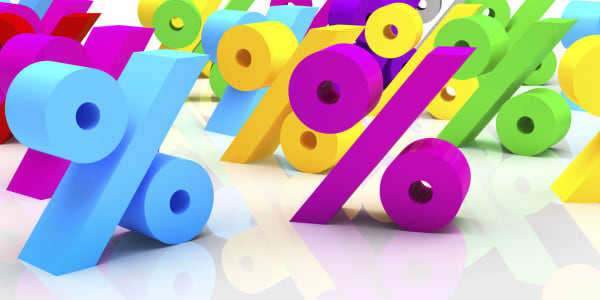Federal funds rate at 1.75 percent by 2016? No problem. ...
Think today's rising interest rates pose a potential problem for fixed-income investors? Get a load of this unscientific survey of some of the all-time-high annual rates from around the world—from Argentina and Turkey to ZImbabwe and Weimar Germany—recorded by various sources over the last century (and no, the rates—however high—aren't typos!)
By Kenneth Kiesnoski, CNBC.com
Posted 14 March 2014
Argentina: 69,653,500%
While benchmark interest rates out of Buenos Aires currently hover around 16 percent, the figures have averaged 317,540.86 percent for the last 35 years. The money market rate briefly peaked at nearly 70 million percent in March of 1990, back when inflation and stagnation was wreaking havoc on the once-booming Argentinian economy.
Neighboring Brazil, too, saw rocketing rates that year, with a daily benchmark interest rate of about 3 percent—which tallied up to 790,799 percent annually.
Source: Tradingeconomics.com/International Monetary Fund; Globalfinancialdata.com
Weimar Germany: 7,950%
The economic travails of Germany's ill-fated, hyperinflated interwar Weimar Republic—partly, and infamously, to blame for the subsequent rise of Adolf Hitler and the Nazi Party—also included soaring inflation and interest rates. An example of the latter was the 7,950 percent rate, amounting to 9 percent per week, reportedly charged at the Berlin Stock Exchange in October 1923. (The German mark was trading at more than 4.2 trillion to the U.S. dollar that year.)
As a member of the euro zone, modern-day Germany currently has a benchmark interest rate, set by the European Central Bank, of 0.25 percent.
Source: Globalfinancialdata.com
Zimbabwe: 4,000%
Amid soaring inflation topping 231 million percent in 2008, the Reserve Bank of Zimbabwe set an overnight or bank interest rate of 4,000 percent in its annual report for the year.
But interest rates, along with other economic indicators, have improved markedly since early 2009, when the government replaced local currency with the U.S. dollar. The average benchmark rate between 2011 and 2013 has hovered around 13.33 percent.
Sources: Reserve Bank of Zimbabwe/Central Statistical Office; Tradingeconomics.com
Turkey: 500%
Turkey's highest-ever benchmark interest rate was 500 percent, recorded in March of 1994, during a short-lived economic crisis under the government of Prime Minister Tansu Ciller. Overall, Turkish rates have averaged an appreciably lower 60.41 percent in the near quarter-century since 1990. Current interest rates in Turkey are about 10 percent.
Source: Tradingeconomics.com/Central Bank of the Republic of Turkey
U.S.: 20%
Back home here in the States, interest rates have averaged just over 6 percent for the last four decades. The all-time high was the "mere" 20 percent rate—peanuts compared to the global record-setters—set by the Board of Governors of the Federal Reserve and the Federal Open Market Committee back in early 1981.
Source: Tradingeconomics.com/Federal Reserve




